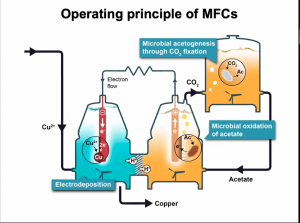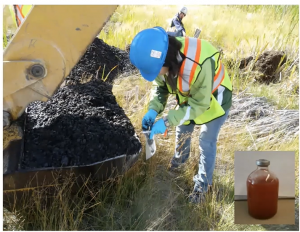Turning Waste into a Remedy: Biochar’s emerging Role in Mine Remediation
By Amzy Vallenas & Susan Baldwin
July 2025
Mining has been central to the development of modern society and remains critical to the transition to a low carbon future. Essential materials such as copper, lithium, and rare earths are building blocks of renewable energy systems, electric vehicles, and energy storage technologies. However, mining leaves behind a huge environmental legacy, particularly mine-impacted water (MIW), which remains one of the industries biggest challenges.
In 2013 alone, mining operations in Canada discharged almost 2000 million cubic meters of used waters (Environment and Climate Change Canada, 2017). Conventional treatments are often expensive, energy-intensive and difficult to scale. But what if there was a low-tech, nature-inspired, scalable solution that could treat pollution and sequester carbon at the same time?
Biochar is a stable, carbon-rich material made by pyrolysis of biomass like agricultural residues or forestry and sawmill waste. Long used to improve soil quality, biochar is gaining attention for its potential in environmental remediation in mining context. Biochar’s key properties make it ideal for adsorbing pollutants, neutralize acidity, lock carbon in the soil, and support microbial activity (Figure 1).

At the Baldwin Lab in UBC’s Department of Chemical and Biological Engineering, we are exploring how biochar can enhance semi-passive remediation systems that treat mine-impacted water and lock carbon underground. Specifically, our research focuses on the role of biochar in sulfate-reducing bacteria (SRB) growth, a group of anaerobic microbes capable of transforming dissolved sulfates into sulfides, supporting the precipitation of metals in MIW. Early findings from our lab suggest that certain biochars can retain dissolved organic carbon compounds and support beneficial bacterial growth. This means that biochar has the potential to enhance nature-based solutions for climate-smart MIW remediation.
In June 2025, we had the opportunity to attend and present at the Biochar Summit 2025 in Brussels, where scientist, industry leaders and innovators gathered to explore how biochar can be a keystone material in climate-smart systems. During the event, we learned how biochar is being used to replace fossil coal in the metal alloy industry, create circular water treatment systems, remove emerging contaminants and foster carbon dioxide removal at scale. The key takeaway? Biochar is not just a soil amendment anymore. It’s becoming a circular material that bridges waste recovery, environmental restoration, and long-term climate goals. This aligns perfectly with industry’s growing push toward ESG commitments, net-zero pathways, and nature-positive mining.
Mining closure is no longer the end, but rather the beginning of a long-term responsibility for regeneration. To meet this challenge, biochar-enhanced treatment systems offer a nature-based approach to managing contaminated water. Pyrolysis technologies can convert local biomass into remediation materials, while surrounding ecosystems are revitalized using carbon-enriched soils. Together, these systems repair water and land resources, while delivering measurable climate benefits through durable carbon sequestration.
References
Environment and Climate Change Canada. 2017. Water withdrawal and consumption by sector [Research report]. Government of Canada. https://www.canada.ca/en/environment-climate-change/services/environmental-indicators/water-withdrawal-consumption-sector.html
Hui Zhu, Qing An, Amirah Syafika Mohd Nasir, Alexandre Babin, Sofia Lucero Saucedo, Amzy Vallenas, Loretta Li, Susan A. Baldwin, Anthony Lau, Xiaotao Bi. 2023. Emerging applications of biochar: A review on techno-environmental-economic aspects. Bioresource Technology. Volume 388. https://doi.org/10.1016/j.biortech.2023.129745.











